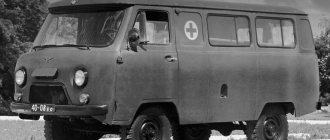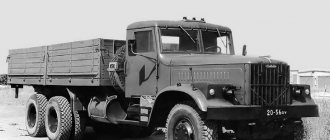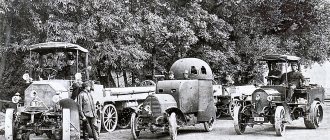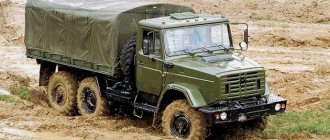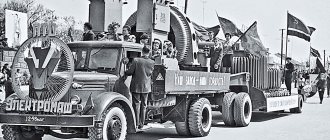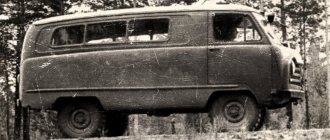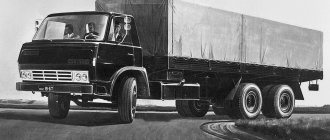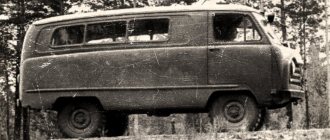Author: Vossen
May 24, 2016 10:17
Tags: USSR trucks prototypes development
8666
38
Before computer modeling existed, each successful production prototype was preceded by dozens of models that barely made it beyond the testing grounds. When the army needed a four-axle heavy rocket carrier, several secret design bureaus from all over the Union began working on the project of such a vehicle. Today let us remember what non-trivial solutions they proposed.
0
Source:
See all photos in the gallery
Artillery installation "Msta-K" (photo Central Research Institute "Burevestnik")
0
Source:
The origins of Soviet four-axle military vehicles with an 8x8 wheel arrangement go back to the early 1930s, when the head of the department of armored vehicles of the Military Academy of Mechanization and Motorization of the Red Army (VAMM RKKA), Evgeniy Alekseevich Chudakov, a future prominent Soviet theorist, took up the design of such equipment. Under his leadership, a running model was designed and built on eight driving single-pitch wheels, with which Chudakov tried to carry out his research on the cross-country ability and stability of vehicles on the ground. The vehicle was equipped with an experienced Soviet 87-horsepower Koju diesel engine (manufactured by the Yaroslavl Automobile Plant) rear-mounted, independent suspension on all wheels, a cab from an AMO-3 truck, and a canvas or simple box-shaped wooden body. In practice, it did not live up to expectations, and four-axle vehicles were forgotten for a long time. Eight-wheeled model of the Academy of Mechanization of the Red Army. 1934 (from the archive of D. Orlov)
×
0
Source:
Head of the VAMM department Chudakov testing his machine (from the archive of A. Beskurnikov)
In the mid-1950s, with the reorientation to multi-axle all-wheel drive army vehicles, an active competitive struggle between secret design bureaus, enterprises and institutes began, hidden from Soviet citizens and foreign spies, for the right to develop and produce the most advanced four-axle carriers of future missile weapons. These included enterprises of different levels, almost simultaneously and independently of each other, working on orders from the Ministry of Defense in a particularly secret creative environment.
Top secret firstborn
0
Source:
The origins of Soviet four-axle vehicles are considered to be the work of the theoretical scientist, Major General Georgy Vladimirovich Zimelev, carried out since 1947 at the Academy of Armored and Mechanized Forces named after I.V. Stalin. In 1950, on his initiative, an experimental artillery tractor with an electric transmission EATE-1 (ATK-1) was assembled there for towing artillery pieces weighing up to 7 tons. It received two diesel engines with a power of 110 hp each. pp., driving two generator sets and traction electric motors. The short life of the unique car was completed by its transfer to the Minsk Automobile Plant, where it served as one of the prototypes of the MAZ-535 tractor. Twin-engine tractor EATE-1 with electric transmission (from the archive of N. Markov)
0
Source:
Tests of a rear-engine artillery tractor (from the archive of N. Markov)
The Power of the Land of Soviets
They worked for days to finish the car for the holiday. But on November 7, 1932, the four-axle miracle was shown to the country's leadership in Moscow. YAG-12 became one of the symbols of the power of the Land of Soviets, capable, as they wrote, in just a couple of five-year plans, not only to catch up, but also to surpass capitalist countries. The press wrote enthusiastically about the amazing car.
After the holiday, the car was sent to NATI. Of course, from the point of view of cross-country ability, the car with a ground clearance of 320 mm turned out to be phenomenal; it overcame, for example, ditches one and a half meters wide. There was a winch under the body that pulled the car forward and backward. The car reached only 40 km/h and consumed 52 liters of gasoline per 100 km in not the most difficult conditions.
YAG-12 with a ground clearance of 320 mm showed excellent cross-country ability during tests at NATI.
YAG-12 with a ground clearance of 320 mm showed excellent cross-country ability during tests at NATI.
Chetverhoski from the city of palaces and fountains
0
Source:
Photos from the archive of 21 NIITs Among the first developers of multi-axis machines was the Military Research Institute from Petrodvorets. Since the mid-1950s, his design department has been working on four-axle chassis for missile systems. The project for such a machine was developed in 1958, and two years later the Leningrad Automobile Repair Plant No. 61 assembled a 10-ton prototype I-210 (“Product 210”). Its main features were a short-stroke 240-horsepower DKS diesel engine, a tubular backbone frame and an independent torsion bar suspension, modeled after the Czechoslovakian Tatra trucks. For the driver and crew commander, there were two separate single-seat cabins with external corrugated panels, between which it was planned to place the front part of the launch ramp with the missile system. Model of the I-210 truck with a 240-horsepower diesel engine. 1959
0
Source:
Truck I-210 with a backbone frame and an all-metal body
0
Source:
Testing of a 10-ton I-210 vehicle at the NIIAP test site. 1960
0
Source:
After being renamed the 21st Scientific Research and Testing Institute (21 NIII), the I-210 was delivered to the town of Bronnitsy near Moscow. In the summer of 1961, it was presented to the leadership of the Ministry of Defense, but after comparative tests a decision was made in favor of the ZIL-135L chassis. Meanwhile, the designers of the 21st Research Institute were already working on a family of two-, three- and four-axle army flatbed trucks, tractors and special chassis. Of these, in 1962, only the 15-ton version of the I-21-15 was ready, differing from the I-210 only in a 340-horsepower turbocharged engine and an extended body. Subsequently, it underwent various tests, but due to the unusual nature of its design, it lost to simpler machines. Diesel 340-horsepower truck I-21-15 designed by 21 NIII. 1962
Four-axle dump trucks: a prudent market
A four-axle dump truck is the most efficient vehicle for many transporters and construction workers. Today, such cars in Siberia will not surprise anyone. However, experts note an increasing increase in demand for this equipment. Why is there polarization of demand in the four-axle dump truck segment? Our correspondent was looking for the answer to this and other questions.
Foreign format
Spring suggests a revival in demand for construction equipment. In particular, consumer interest in dump trucks increases already in February-March. In the market of trucks and dump trucks, starting from the first post-crisis year, a significant share of new buyers are individuals and organizations. Therefore, if for some of them a three-axle dump truck is optimal, then for operation in conditions with other production tasks, it is advisable to use four-axle dump trucks, since the more cargo is transported at a time, the more profitable the transportation. A four-axle dump truck is an acceptable option to provide increased load capacity without increasing the standard axle load.
Note that the question of where to use four-axle vehicles more effectively is no longer on the agenda?
The relative popularity of four-axle dump trucks is understandable and has been steadily growing since the past crisis. There is an opinion that dump trucks with a wheel arrangement (8x4) are more likely to be used for mainline transport. The main customers of such equipment are fleets of construction materials quarries, construction industry enterprises that need to transport large volumes of inert bulk cargo on relatively good roads and, as a rule, construction companies that need to quickly remove huge volumes of soil during zero-cycle excavation work. In fact, it is quite difficult to differentiate between customers into three- and four-axis equipment. Oleg Vasilchenko, PR manager of Volvo Vostok JSC .
Vitaly Berezovsky, director (Novosibirsk), agrees with him
“3-axle equipment is mainly used at small local municipal facilities and construction sites. In turn, four-axle dump trucks are used where larger volumes need to be removed, at large sites, including construction materials quarries.”
Ivan Butorov, director of Commercial Transport LLC from Krasnoyarsk, estimates the ratio of 3- and 4-axle dump trucks in the region as 5/1:
“Four-axle dump trucks are multi-purpose vehicles, and their choice depends on the volume and weight of the cargo being transported. They are purchased for transporting larger loads, and 3-axle dump trucks are purchased for heavy soil and rocks.”
Anton Borodulin, Deputy Commercial Director, draws attention to competition with four-axle dump trucks from other vehicles
“As a rule, four-axle dump trucks are used within the city to transport inert bulk cargo, as well as snow. Four-axle dump trucks are not purchased as often as three-axle dump trucks. This is due to the fact that the cost of such a vehicle is slightly lower than the cost of a tractor + dump semi-trailer coupling (for example, MAZ6422A8 and TONAR9523 . And although the hitch is more expensive, it wins in terms of the volume of cargo transported, the carrying capacity, and the versatility of the process.”
Just a few years ago, experts interviewed by the magazine estimated the sales ratio between 3-axle and four-axle dump trucks as 95/5 or 90/10. Today, experts assess the market ratio somewhat differently, which is due to the increasing interest of customers in this technology.
“Before 2012, the ratio was 80% to 20%; in 2012 it was already 60% to 40%. The popularity of four-axle vehicles has increased. The main factors for this growth were increased load capacity, reliability, engine power and efficiency, a durable frame and chassis, and the ability to work in low temperatures,” notes Oleg Vasilchenko from Volvo Vostok JSC.
The same market ratio is noted by Vitaly Berezovsky from Novosibirsk:
“The ratio of sales of three and four-axle dump trucks out of 10 is six for a conventional three-axle dump truck.”
As experts note, the post-crisis buyer expects longer and more stable operation of the equipment. Therefore, now the criteria for choosing brands have changed somewhat. The bar for requirements for equipment has risen - now you rarely see those who buy for future use, for example, as they once bought Chinese dump trucks taking into account the so-called “donor” vehicles. Accordingly, the importance of the availability of spare parts for equipment, high-quality service, and reliability of equipment has sharply increased. The cargo carrier and the builder do not want to put up with downtime so that during the construction season the equipment does not stand idle for any reason, including due to a lack of spare parts.
Downtime negatively affects the economy of the enterprise. Vitaly Berezovsky Fr.
Oleg Vasilchenko from Volvo Vostok states:
“The correct selection of vehicle characteristics for transportation allows us to avoid excessive load on components and assemblies and their premature failure. Not only reliability is important, but also timely maintenance – maintenance planning (service contracts).”
Ivan Butorov from Commercial Transport LLC speaks about improving the qualifications of drivers and strictly following operating rules as a recipe for equipment downtime:
“It is necessary to improve the qualifications and professionalism of the driving staff, improve the quality of components and assembly, adherence to operating rules in accordance with the technical parameters of the vehicle (load capacity, etc.)”
MAZ and others
In the middle of the last decade, the automobile market reached the peak of its development, and the shortage of equipment produced in the country led to the massive import of dump trucks from China. Importers of Chinese equipment were the first to bring dump trucks with a wheel arrangement (8x4) to the construction market of the region. In fact, they opened this segment to the Siberian construction market. Four-axle dump trucks from the Middle Kingdom were in very active demand among construction companies, construction industry enterprises, construction materials quarries and other cargo carriers, even despite the unclear situation with spare parts and service. The profit generated from the operation of the four-axle vehicles covered all the shortcomings. Given the high demand, at the same time domestic machine builders began to develop four-axle dump trucks. The Kama Automobile Plant launched the 6540 model. However, it had a carrying capacity that was too low for a “four-axle” vehicle, so it did not become so popular among domestic customers. The modified “6540” is still rolling off the assembly line of the Kama enterprise. But in the production program today the emphasis is on a more powerful four-axle vehicle - model 65201.
AZ "Ural" produces the "6563" model with an 8x4 wheel arrangement, a body of 16 cubic meters and a carrying capacity of 25 tons. There is also an 8x8 off-road version in the model range.
Minsk Automobile Plant , did not stand aside from the market trend , which in 2008 presented a model of the four-axle dump truck MAZ-6516A8 . The model was further developed.
“The most popular model of four-axle dump trucks in the MAZ is 6516A9321 . This model is equipped with a YaMZ650.10 engine, assembled under license from Renault. Fast Gear transmission . Has a body volume of 21 cubic meters. m, capacity 25 tons,” notes Anton Borodulin from. — Since 2013, the Minsk Automobile Plant began supplying four-axle dump trucks equipped with Euro4 environmental class engines to the Russian market. “6516B9480000” model , which is distinguished by the presence of an exhaust gas recirculation system, and the “6516W8” , equipped with a 400-horsepower Cummins .”
Among the design features of MAZ , we note the presence of a heated platform, which is important in the Siberian climate, as well as the presence of EPGV (electric-pneumatic-hydraulic outlets) for working with dump trailers. All cars are equipped with an engine heater and an independent air heater for the driver's cabin (optional). Since dump trucks are designed to solve specific operating problems in various conditions, including particularly difficult road conditions, they are equipped with a reinforced frame (spar in spar), which makes the dump truck “strong” and reliable in operation.
Chinese jerk
In the regions of the Siberian Federal District, you can still find on the roads already well-used four-axle dump trucks, imported into the country in the pre-crisis period. And although at that time it was mainly Howo , today the interest of customers is diversified. The center of gravity of demand, due to the development of a network of official dealers, has shifted to other brands of Chinese trucks: Shacman , FAW , Foton , JAC , DongFeng , CAMC .
One of the interesting Chinese four-axle dump truck models is FAW C3312P2K2LT4E (8x4). Traditionally, cars made in China are difficult to index. But this is not the main thing. Vitaly Berezovsky from Techno-Business LLC Fr.
The dump truck has a capacity of 30 tons, a body volume of 23.5 cubic meters, and an engine power of 350 hp. It is important that the warranty mileage is 65,000 km.
Ivan Butorov adds:
“The machines are multi-purpose, but it all depends on the volume and weight of the cargo being transported. Frame spar in spar, front body lift, increased fuel tank volume (up to 400 l), heated body, engine developed by the engineering company AVL LIST GMBH (Graz, Austria) . For operation in Siberian conditions, all rubber products are made of materials resistant to low temperatures, the vehicle is equipped with an engine pre-heater, and has an insulated cabin.”
Growing class
However, despite the popularity of Chinese technology, cars that offer durable, reliable and, most importantly, economical technology have gained a foothold in this segment. Despite the high price tag, in comparison with domestic analogues, consumers who are committed to long-term business expect to receive all the benefits from operating such dump trucks.
According to Oleg Vasilchenko, the model range of the Swedish manufacturer Volvo on the domestic market includes a four-axle FMX 8×4 D13F with a power of 400 hp. This is a construction dump truck specially designed for transportation, adapted to work in difficult conditions of construction sites, quarries, etc.
“The most powerful chassis in its class, load capacity up to 30 tons, maintenance-free chassis. Steering with two hydraulic pumps - the main one on the engine and an additional one on the gearbox, which retains the ability to turn the wheels even when the engine is stopped. Wide range of possibilities for adapting the chassis to customer requests: increasing engine power, preparing for a trailer, sleeping cabin. Heating of the fuel system (lines, filters), autonomous heater,” notes Oleg Vasilchenko.
The machine was presented in 2010 at the German construction exhibition Bauma and the domestic Comtrans and then became one of the most high-profile debuts. FMX cab has a bumper with a protective arch, providing an increased approach angle. The power unit is protected from below by a 4-mm steel plate, the car has scratch-resistant mirrors, and the headlights are covered with grilles. The machine is equipped with special sensors that transmit information about the loading of the body, which ensures a smooth start and switching of gear stages.
Until recently, Renault dump trucks were little known to Russian builders, but recently sales of trucks from the Kerax construction series have intensified. Renault Kerax 440.42 8x4 HD model is available The car has a new 11-liter 440-horsepower engine, also installed on Premium Vostok long-haul vehicles, which has proven itself well in Russia. The car chassis, originally designed for off-road use, has reinforced side members (300x90x8 mm) and a special additional 5 mm reinforcing insert. The maximum load on the front axles is 9 tons, on the rear bogie - 32 tons.
Swedish Scania offers Russian consumers one model of the P380 CB8x4EHZ (8x4) dump truck, equipped with a 380-horsepower engine. The machine is characterized by increased axle loads - 9 tons on the front axles and 30 tons on the rear bogie.
Exercises of scientific minds
0
Source:
Photos without links - from the NAMI archive In the spring of 1958, on instructions from the Ministry of Defense, work on four-axle technology began at the Scientific Automotive Institute (NAMI) under the leadership of Nikolai Ivanovich Korotonoshko. In 1960, a tractor-trailer NAMI-058 with a carrying capacity of eight to nine tons was built there. The vehicle was equipped with a V12 tank diesel engine with a capacity of 275 hp. s., a gearbox from an AT-S tracked artillery tractor and parts from a Ural-375 truck. The original components that remained were the spar frame with cross members from the Urals, a two-stage transfer case with a center differential and two separate cabins with panoramic windshields. Even in the process of designing the car, the Stalingrad military design bureau proactively developed a preliminary design for mounting the launcher of the future Luna missile system on this chassis, but with the advent of more practical designs, this work was frozen. Experienced 275-horsepower car NAMI-058 with a V12 diesel engine. 1960
0
Source:
Layout diagram of the NAMI-058 truck with four drive axles
0
Source:
Project of the Br-226-III launcher for the Luna complex (from the archive)
0
Source:
The first pancake came out lumpy: the complex and heavy NAMI-058 lost comparative tests, but in 1964 it appeared in the NAMI-058T version with a 320-horsepower V8 diesel engine and a single wide cabin with two flat windshields. And again, the overly complex, heavy and expensive machine lost to its simpler competitors. Upgraded NAMI-058T with a 320-horsepower V8 engine. 1964
0
Source:
In 1968, the development of the four-axle theme was the multi-purpose 240-horsepower bonneted vehicle NAMI-0127 with an articulated frame and a cab from the ZIL-130. Among its options was an army truck with an all-metal cargo bed, wide-profile, arched tires or pneumatic rollers. Experimental articulated vehicle NAMI-0127. 1968
0
Source:
Military version with all-metal body and arched tires
0
Source:
In 1984, a cabover model NAMI-0188 with an extended KamAZ cab, mounted on eight arched tires, appeared. It could be used for the delivery of long special cargo and the installation of large army superstructures. Trial cabover model NAMI-0188 on arched tires. 1984
All these structures completed the long dead-end exercises of NAMI scientists in the four-axis sphere, and in the future the Ministry of Defense preferred to entrust such developments only to the largest Soviet enterprises.
Bryansk imitators
0
Source:
Photos from the BAZ archive In the early 1960s, the young Bryansk Automobile Plant (BAZ) made several bold attempts to create its own four-axle vehicles for installing and transporting future missile weapons systems. This work was carried out on orders from the Ministry of Defense at the factory design bureau under the leadership of chief designer Rafail Aleksandrovich Rozov. The models built there could not yet help but copy the cars of the Moscow Automobile Plant, but they occupied their niche in the cohort of the first Soviet multi-axle cars. In the summer of 1961, the Bryansk SKB completed the development of a 10-ton BAZ-930 truck (“Izdeliye 930”) for the promising Luna-M missile system. For lack of anything else, it was built on a ZIL-135E twin-engine chassis with an onboard transmission, but unlike the Moscow prototype, it was equipped with an experienced hydromechanical transmission designed by NAMI and its own simplified fiberglass cabin. Immediately upon completion of assembly, the car was poisoned at the 21st Research Institute, from where it was transported to Moscow to be shown to the leadership of the Ministry of Defense. This is what military test driver M.A. Khokhlov recalls about this event: “More than once, unfinished equipment let us down. One day I was sent to show a new four-axle car, the BAZ-930. While driving from Bronnitsy to Moscow, two wheels came off. We arrived without them. And at the show site, the brackets for securing these wheels were welded…” The Bryansk truck turned out to be heavier than the others and did not have sufficient maneuverability. By decision of the military commission in March 1962, the 930 project was rejected. Experienced 10-ton truck BAZ-930 with a plastic cab. 1961
0
Source:
BAZ-930 with two 180-horsepower V8 engines and torsion bar suspension
0
Source:
In the same year, the BAZ-931 long-wheelbase vehicle chassis for missile weapons was built. This was a fundamentally new design, combined from the most progressive units at that time. Based on the I-210 model, it was equipped with a tubular spinal frame, an onboard transmission from the ZIL-135 and a hydropneumatic suspension with parts from the chassis of the MiG-15 fighter. Like the BAZ-930, it also turned out to be “raw” and did not pass the tests. Long-wheelbase truck BAZ-931 with spaced pairs of axles. 1962
0
Source:
Other four-axle developments at BAZ include a running prototype of an amphibious infantry fighting vehicle (IFV), codenamed “Object 1200.” It was equipped with a 300-horsepower V6 diesel engine, hydropneumatic suspension and water cannons from the PT-76 tank. The Object 1200 successfully passed tests, but the military preferred a tracked vehicle, later known as the BMP-1. Model amphibious armored vehicle "Object 1200". 1965 (film still)
0
Source:
“Object 1200” with hydropneumatic suspension in the museum in Kubinka (photo by the author)
Forgotten passions 8×8: experimental four-axle trucks in the USSR
Home » Smoking room. Anything and everything your heart desires. » Forgotten passions 8×8: experimental four-axle trucks in the USSR
Smoking room. Everything and about everything your heart desires. Unsold and little-known weapons
redstar72 08/14/2016 1168
1
to Favoritesin Favoritesfrom Favorites 2
Before computer modeling existed, each successful production prototype was preceded by dozens of models that barely made it beyond the testing grounds. When the army needed a four-axle heavy rocket carrier, several secret design bureaus from all over the Union began working on the project of such a vehicle. Today let us remember what non-trivial solutions they proposed.
The origins of Soviet four-axle military vehicles with an 8x8 wheel arrangement go back to the early 1930s, when the head of the department of armored vehicles of the Military Academy of Mechanization and Motorization of the Red Army (VAMM RKKA) Evgeniy Alekseevich Chudakov, a future prominent Soviet theoretical scientist, took up the design of such equipment. .
Under his leadership, a running model was designed and built on eight driving single-pitch wheels, with which Chudakov tried to carry out his research on the cross-country ability and stability of vehicles on the ground. The vehicle was equipped with an experienced Soviet 87-horsepower Koju diesel engine (manufactured by the Yaroslavl Automobile Plant) rear-mounted, independent suspension on all wheels, a cab from an AMO-3 truck, and a canvas or simple box-shaped wooden body. In practice, it did not live up to expectations, and four-axle vehicles were forgotten for a long time.
Eight-wheeled model of the Academy of Mechanization of the Red Army. 1934 (from the archive of D. Orlov)
Head of the VAMM department Chudakov testing his machine (from the archive of A. Beskurnikov)
In the mid-1950s, with the reorientation to multi-axle all-wheel drive army vehicles, an active competitive struggle between secret design bureaus, enterprises and institutes began, hidden from Soviet citizens and foreign spies, for the right to develop and produce the most advanced four-axle carriers of future missile weapons. These included enterprises of different levels, almost simultaneously and independently of each other, working on orders from the Ministry of Defense in a particularly secret creative environment.
Top secret firstborn
The origins of Soviet four-axle vehicles are considered to be the work of the theoretical scientist, Major General Georgy Vladimirovich Zimelev, carried out since 1947 at the Academy of Armored and Mechanized Forces named after I.V. Stalin. In 1950, on his initiative, an experimental artillery tractor with an electric transmission EATE-1 (ATK-1) was assembled there for towing artillery pieces weighing up to 7 tons. It received two diesel engines with a power of 110 hp each, driving two generator sets and traction electric motors. The short life of the unique car was completed by its transfer to the Minsk Automobile Plant, where it served as one of the prototypes of the MAZ-535 tractor.
Twin-engine tractor EATE-1 with electric transmission (from the archive of N. Markov)
Tests of a rear-engine artillery tractor (from the archive of N. Markov)
Chetverhoski from the city of palaces and fountains
Photos from the archives of 21 Scientific Research Center
Among the first developers of multi-axle machines was the Military Research Institute from Petrodvorets. Since the mid-1950s, his design department has been working on four-axle chassis for missile systems. The project for such a machine was developed in 1958, and two years later the Leningrad Automobile Repair Plant No. 61 assembled a 10-ton prototype I-210 (“Product 210”).
Its main features were a short-stroke 240-horsepower DKS diesel engine, a tubular backbone frame and an independent torsion bar suspension, modeled after the Czechoslovakian Tatra trucks. For the driver and crew commander, there were two separate single-seat cabins with external corrugated panels, between which it was planned to place the front part of the launch ramp with the missile system.
Model of the I-210 truck with a 240-horsepower diesel engine. 1959
Truck I-210 with a backbone frame and an all-metal body
Testing of a 10-ton I-210 vehicle at the NIIAP test site. 1960
After being renamed the 21st Scientific Research and Testing Institute (21 NIII), the I-210 was delivered to the town of Bronnitsy near Moscow. In the summer of 1961, it was presented to the leadership of the Ministry of Defense, but after comparative tests a decision was made in favor of the ZIL-135L chassis. Meanwhile, the designers of the 21st Research Institute were already working on a family of two-, three- and four-axle army flatbed trucks, tractors and special chassis. Of these, in 1962, only the 15-ton version of the I-21-15 was ready, differing from the I-210 only in a 340-horsepower turbocharged engine and an extended body. Subsequently, it underwent various tests, but due to the unusual nature of its design, it lost to simpler machines.
Diesel 340-horsepower truck I-21-15 designed by 21 NIII. 1962
Exercises of scientific minds
Photos without links - from the NAMI archive
In the spring of 1958, on instructions from the Ministry of Defense, work on four-axle technology began at the Scientific Automotive Institute (NAMI) under the leadership of Nikolai Ivanovich Korotonoshko. In 1960, a tractor-trailer NAMI-058 with a carrying capacity of eight to nine tons was built there. The vehicle was equipped with a V12 tank diesel engine with a power of 275 hp, a gearbox from an AT-S tracked artillery tractor and parts from a Ural-375 truck. The original components that remained were the spar frame with cross members from the Urals, a two-stage transfer case with a center differential and two separate cabins with panoramic windshields. Even in the process of designing the car, the Stalingrad military design bureau proactively developed a preliminary design for mounting the launcher of the future Luna missile system on this chassis, but with the advent of more practical designs, this work was frozen.
Experienced 275-horsepower car NAMI-058 with a V12 diesel engine. 1960
Layout diagram of the NAMI-058 truck with four drive axles
Project of the Br-226-III launcher for the Luna complex (from the archive)
The first pancake came out lumpy: the complex and heavy NAMI-058 lost comparative tests, but in 1964 it appeared in the NAMI-058T version with a 320-horsepower V8 diesel engine and a single wide cabin with two flat windshields. And again, the overly complex, heavy and expensive machine lost to its simpler competitors.
Upgraded NAMI-058T with a 320-horsepower V8 engine. 1964
In 1968, the development of the four-axle theme was the multi-purpose 240-horsepower bonneted vehicle NAMI-0127 with an articulated frame and a cab from the ZIL-130. Among its options was an army truck with an all-metal cargo bed, wide-profile, arched tires or pneumatic rollers.
Experimental articulated vehicle NAMI-0127. 1968
Military version with all-metal body and arched tires
In 1984, a cabover model NAMI-0188 with an extended KamAZ cab, mounted on eight arched tires, appeared. It could be used for the delivery of long special cargo and the installation of large army superstructures.
Trial cabover model NAMI-0188 on arched tires. 1984
All these structures completed the long dead-end exercises of NAMI scientists in the four-axis sphere, and in the future the Ministry of Defense preferred to entrust such developments only to the largest Soviet enterprises.
Bryansk imitators
Photos from the BAZ archive
In the early 1960s, the young Bryansk Automobile Plant (BAZ) made several bold attempts to create its own four-axle vehicles for the installation and transportation of future missile weapons systems. This work was carried out on orders from the Ministry of Defense at the factory design bureau under the leadership of chief designer Rafail Aleksandrovich Rozov. The models built there could not yet help but copy the cars of the Moscow Automobile Plant, but they occupied their niche in the cohort of the first Soviet multi-axle cars.
In the summer of 1961, the Bryansk SKB completed the development of a 10-ton BAZ-930 truck (“Izdeliye 930”) for the promising Luna-M missile system. For lack of anything else, it was built on a ZIL-135E twin-engine chassis with an onboard transmission, but unlike the Moscow prototype, it was equipped with an experienced hydromechanical transmission designed by NAMI and its own simplified fiberglass cabin.
Immediately upon completion of assembly, the car was poisoned at the 21st Research Institute, from where it was transported to Moscow to be shown to the leadership of the Ministry of Defense. This is what military test driver M.A. recalls about this event. Khokhlov:
“We have been let down by unfinished technology more than once. One day I was sent to show a new four-axle car, the BAZ-930. While driving from Bronnitsy to Moscow, two wheels came off. We arrived without them. And at the show site, the mounting brackets for these wheels were welded...”
The Bryansk truck turned out to be heavier than others and did not have sufficient maneuverability. By decision of the military commission in March 1962, the 930 project was rejected.
Experienced 10-ton truck BAZ-930 with a plastic cab. 1961
BAZ-930 with two 180-horsepower V8 engines and torsion bar suspension
In the same year, the BAZ-931 long-wheelbase vehicle chassis for missile weapons was built. This was a fundamentally new design, combined from the most progressive units at that time. Based on the I-210 model, it was equipped with a tubular spinal frame, an onboard transmission from the ZIL-135 and a hydropneumatic suspension with parts from the chassis of the MiG-15 fighter. Like the BAZ-930, it also turned out to be “raw” and did not pass the tests.
Long-wheelbase truck BAZ-931 with spaced pairs of axles. 1962
Other four-axle developments at BAZ include a running prototype of an amphibious infantry fighting vehicle (IFV), codenamed “Object 1200.” It was equipped with a 300-horsepower V6 diesel engine, hydropneumatic suspension and water cannons from the PT-76 tank. The Object 1200 successfully passed tests, but the military preferred a tracked vehicle, later known as the BMP-1.
Model amphibious armored vehicle "Object 1200". 1965 (film still)
“Object 1200” with hydropneumatic suspension in the museum in Kubinka (photo by the author)
Caucasian prospectors: from armored cars and rocket carriers to trucks
Photos from the archive of V. Korovin
One of the first to work on four-axle topics was the Kutaisi Automobile Plant (KAZ), famous for truck tractors, which were practically not used by the troops. At the end of 1958, a secret design bureau was created there. The scope of his activities was limited to the assembly, testing and modification of prototypes of an amphibious combat vehicle developed at the Academy of Armored and Mechanized Forces. In terms of general design, the military equipment from Kutaisi was a further embodiment of the developments of SKB ZIL and was equipped with ZIL-375 engines, onboard transmissions and units made in Moscow. Local originalities included an independent suspension on coil springs and torsion bars with adjustable hydropneumatic shock absorbers.
Kutaisi prototype of the amphibious armored personnel carrier "Object 1015B". 1960
When the BTR-60P armored personnel carrier became the winner of the competition for new armored vehicles, the Kutaisi combat vehicles were converted into elongated covered hull chassis for mounting missile systems. In 1964, the plant presented two samples to carry the first version of the Osa anti-aircraft complex with a separate launcher and antenna unit, which turned out to be too heavy. And in the future, all the efforts of Georgian designers focused on the problem of reducing the weight of the chassis, which would make it possible to increase maneuverability, range and deliver them by air. This work continued unsuccessfully until July 1968.
Floating chassis "Object 1040" with a high, flat hull. 1961
Lightweight chassis "Object 1045" for the Osa anti-aircraft complex. 1964
Tests of the “1045” chassis with the overall weight model of the “Osa” complex
The plant's only achievement in the military automotive field was the four-axle 4.5-ton KAZ-604B truck. It was equipped with a 150-horsepower engine from the ZIL-130, an onboard transmission with two-stage final drives, an original torsion spring suspension and a cabin from the KAZ-606A truck tractor with the inscription “Colchis”. During parallel development of more promising and reliable machines, the issue of its serial production was not considered.
Experienced army 4.5-ton vehicle KAZ-604B (from the archives of the 21st Scientific Research Center)
Tests of a 150-horsepower KAZ-604B truck with an onboard transmission (from the author’s archive)
From subway cars to rocket carriers
Until now, few people know that the Mytishchi Machine-Building Plant (MMZ) near Moscow, known to the general public only for its metro cars, at various times produced tracked military equipment and special chassis for powerful missile systems. The creation of wheeled vehicles at MMZ was the only and very short episode of its long history, which did not in any way affect the main activities of the plant.
At the end of the 1950s, the secret OKB-40 of the Mytishchi Machine Plant received a military order to develop floating hull chassis for anti-aircraft missile systems. In the early 1960s, with an eye on the work of the Minsk SKB-1, the plant assembled a four-axle amphibious chassis “Object 560” or MMZ-560 with a characteristic low-sided load-bearing armored hull with a flat roof for installing special items. In its rear part there was a 525-horsepower V12 diesel engine and a hydromechanical transmission. From it, the torque was distributed by cardan shafts to rear solid drive axles with wheel gearboxes from ZIL-135, to two pairs of front steered wheels and two propellers.
Floating hull chassis MMZ-560. 1960 (from the archive of V. Korovin)
Initially, the chassis was planned to be used for the Osa anti-aircraft missile system, but it lost comparative tests, turning out to be the heaviest, most massive and unmaneuverable. In 1963, a prototype of the “Cube” missile system was mounted on it, but the military unanimously preferred tracked vehicles of the MMZ brand. Then they tried to use the chassis to carry the Yastreb operational-tactical complex. Its prototype was tested in Bronnitsy, but this idea was not fully implemented.
Testing the MMZ-560 chassis with a mock-up of the Yastreb complex. 1963 (footage from filming of the 21st Scientific Research Institute)
Kremenchug “discoverers”
In 1982, in the experimental workshop of the Kremenchug Automobile Plant, two heavy all-wheel drive cabover chassis were assembled, maximally unified with KrAZ-260 trucks. They were part of the Otkritie military family, the leading designer of which was Vladislav Konstantinovich Levsky. Unlike serial production, these machines received the CR index, which was unusual for the plant, meaning “one-time drawing.”
Heavy army truck KrAZ ChR-3130. 1982 (from the archives of 21 Research Centers)
The ChR-3130 chassis was a 16-ton truck with an extended frame, a tented all-metal body from the KrAZ-260 vehicle and a massive, non-folding, elevated cab, which was based on the cabin from the 260th KrAZ without a front hood. Behind it was a V8 engine with a power of 360 hp, adapted to run on diesel fuel, gasoline, kerosene or their mixtures with rocket fuel. The manual 10-speed gearbox was located in a tunnel under the cabin. In the second version, the cabin had a simplified front facing, and the folded awning was placed in a special box next to the engine compartment.
The second version of the 16-ton vehicle ChR-3130 (from the archives of V. Levsky)
KrAZ ChR-3130 military truck after testing (photo by V. Novoselov)
In the mid-1980s, an experimental self-propelled 152-mm howitzer "Msta-K" with an armored artillery unit and a firing range of up to 25 km, generally identical to the tracked version, was assembled at the secret Gorky Central Research Institute "Burevestnik" on a modified ChR-3130 chassis with folding jacks. "Msta-S". As with variants on other automobile chassis, the strength of the Ukrainian chassis did not meet military requirements.
Artillery installation "Msta-K" (photo Central Research Institute "Burevestnik")
The second 360-horsepower chassis model, the ChR-3120, with an articulated frame, was revolutionary for Soviet vehicles. It differed from the ChR-3130 model in a two-section frame with a vertical hinge, around which the machine was rotated using hydraulic cylinders that deflected both sections at an angle of up to 40° in each direction. This system with a traditional steering mechanism from KrAZ-255B and a spool pressure distributor was developed and assembled at NAMI, and then transferred to KrAZ. The open rear section, which played the role of a replaceable active semi-trailer chassis, housed a 6.5-meter cargo platform.
Unique 16-ton truck ChR-3120 with an articulated frame (from the archives of 21 Scientific Research Center)
Long-wheelbase 18-ton vehicle CR-3120.02. 1983 (from the archive of V. Levsky)
In 1983, a long-wheelbase version of the ChR-3120.02 appeared with an installation frame length of 10 m, the load capacity of which increased from 16 to 18 tons.
Tests of the articulated vehicle ChR-3120.02 (from the archives of the 21st Scientific Research Center)
Both chassis turned out to be too heavy, complex, expensive and remained unclaimed during perestroika, bringing an end to the long experimental phase of the Soviet period in the creation of four-axle military vehicles of unconventional designs.
Evgeniy KOCHNEV
source: https://www.kolesa.ru/article/zabytye-strasti-8×8-eksperimentalnye-chetyrehosnye-gruzoviki-v-sssr
Caucasian prospectors: from armored cars and rocket carriers to trucks
0
Source:
Photos from the archive of V. Korovin One of the first to engage in work on four-axle topics was the Kutaisi Automobile Plant (KAZ), famous for truck tractors, which were practically not used by the troops. At the end of 1958, a secret design bureau was created there. The scope of his activities was limited to the assembly, testing and modification of prototypes of an amphibious combat vehicle developed at the Academy of Armored and Mechanized Forces. In terms of general design, the military equipment from Kutaisi was a further embodiment of the developments of SKB ZIL and was equipped with ZIL-375 engines, onboard transmissions and units made in Moscow. Local originalities included an independent suspension on coil springs and torsion bars with adjustable hydropneumatic shock absorbers. Kutaisi prototype of the amphibious armored personnel carrier "Object 1015B". 1960
0
Source:
When the BTR-60P armored personnel carrier became the winner of the competition for new armored vehicles, the Kutaisi combat vehicles were converted into elongated covered hull chassis for mounting missile systems. In 1964, the plant presented two samples to carry the first version of the Osa anti-aircraft complex with a separate launcher and antenna unit, which turned out to be too heavy. And in the future, all the efforts of Georgian designers focused on the problem of reducing the weight of the chassis, which would make it possible to increase maneuverability, range and deliver them by air. This work continued unsuccessfully until July 1968. Floating chassis "Object 1040" with a high, flat hull. 1961
0
Source:
Lightweight chassis "Object 1045" for the Osa anti-aircraft complex. 1964
0
Source:
Tests of the “1045” chassis with the overall weight model of the “Osa” complex
0
Source:
The plant's only achievement in the military automotive field was the four-axle 4.5-ton KAZ-604B truck. It was equipped with a 150-horsepower engine from the ZIL-130, an onboard transmission with two-stage final drives, an original torsion spring suspension and a cabin from the KAZ-606A truck tractor with the inscription “Colchis”. During parallel development of more promising and reliable machines, the issue of its serial production was not considered. Experienced army 4.5-ton vehicle KAZ-604B (from the archives of the 21st Scientific Research Center)
0
Source:
Tests of a 150-horsepower KAZ-604B truck with an onboard transmission (from the author’s archive)
From meter cars to rocket carriers
0
Source:
Until now, few people know that the Mytishchi Machine-Building Plant (MMZ) near Moscow, known to the general public only for its metro cars, at various times produced tracked military equipment and special chassis for powerful missile systems. The creation of wheeled vehicles at MMZ was the only and very short episode of its long history, which did not in any way affect the main activities of the plant. At the end of the 1950s, the secret OKB-40 of the Mytishchi Machine Plant received a military order to develop floating hull chassis for anti-aircraft missile systems. In the early 1960s, with an eye on the work of the Minsk SKB-1, the plant assembled a four-axle amphibious chassis “Object 560” or MMZ-560 with a characteristic low-sided load-bearing armored hull with a flat roof for installing special items. In its rear part there was a 525-horsepower V12 diesel engine and a hydromechanical transmission. From it, the torque was distributed by cardan shafts to rear solid drive axles with wheel gearboxes from ZIL-135, to two pairs of front steered wheels and two propellers. Floating hull chassis MMZ-560. 1960 (from the archive of V. Korovin)
0
Source:
Initially, the chassis was planned to be used for the Osa anti-aircraft missile system, but it lost comparative tests, turning out to be the heaviest, most massive and unmaneuverable. In 1963, a prototype of the “Cube” missile system was mounted on it, but the military unanimously preferred tracked vehicles of the MMZ brand. Then they tried to use the chassis to carry the Yastreb operational-tactical complex. Its prototype was tested in Bronnitsy, but this idea was not fully implemented.
0
Source:
Testing the MMZ-560 chassis with a mock-up of the Yastreb complex. 1963 (footage from filming of the 21st Scientific Research Institute)
Kremenchug “discoverers”
0
Source:
In 1982, in the experimental workshop of the Kremenchug Automobile Plant, two heavy all-wheel drive cabover chassis were assembled, maximally unified with KrAZ-260 trucks. They were part of the Otkritie military family, the leading designer of which was Vladislav Konstantinovich Levsky. Unlike serial production, these machines received the CR index, which was unusual for the plant, meaning “one-time drawing.” Heavy army truck KrAZ ChR-3130. 1982 (from the archives of 21 Research Centers)
0
Source:
Testing the MMZ-560 chassis with a mock-up of the Yastreb complex. 1963 (footage from filming of the 21st Scientific Research Institute)
Anniversary gift
They decided to make the Soviet four-axle truck YAG-12 for the 15th anniversary of the October Revolution - November 7, 1932. The Yaroslavl people, of course, already had some things. The rear bogie was taken from the serial three-axle YaG‑10 (which is why the Yaroslavl SUV, and unlike the English one, has dual-slope rear wheels). They also took the gearbox from him - a copy of the American Brown.
YaA-2 chassis with a unique, specially welded frame. The distance between the centers of the front wheel and the rear bogie is 7200 mm!
YaA-2 chassis with a unique, specially welded frame. The distance between the centers of the front wheel and the rear bogie is 7200 mm!

